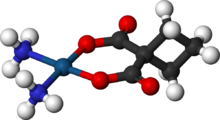Karboplatin
Karboplatin je organsko jedinjenje, koje sadrži 6 atoma ugljenika i ima molekulsku masu od 371,254 Da.[1][2][3][4][5]
 | |
 | |
| Klinički podaci | |
|---|---|
| Prodajno ime | Paraplatin, Paraplatin-AQ |
| Drugs.com | Monografija |
| Način primene | Intravenozno |
| Farmakokinetički podaci | |
| Poluvreme eliminacije | 1,1 - 2 h |
| Izlučivanje | Renalno |
| Identifikatori | |
| CAS broj | 41575-94-4 |
| ATC kod | L01XA02 (WHO) |
| PubChem | CID 38904 |
| DrugBank | DB00958 |
| ChemSpider | 436073 |
| ChEBI | CHEBI:31355 |
| ChEMBL | CHEMBL288376 |
| Hemijski podaci | |
| Formula | C6H12N2O4Pt |
| Molarna masa | 371,254 |
| |
| |
Osobine
уреди| Osobina | Vrednost |
|---|---|
| Broj akceptora vodonika | 6 |
| Broj donora vodonika | 2 |
| Broj rotacionih veza | 0 |
| Particioni koeficijent[6] (ALogP) | 0,1 |
| Rastvorljivost[7] (logS, log(mol/L)) | 1,6 |
| Polarna površina[8] (PSA, Å2) | 122,6 |
Reference
уреди- ^ Natarajan G, Malathi R, Holler E: Increased DNA-binding activity of cis-1,1-cyclobutanedicarboxylatodiammineplatinum(II) (carboplatin) in the presence of nucleophiles and human breast cancer MCF-7 cell cytoplasmic extracts: activation theory revisited. Biochem Pharmacol. 1999 Nov 15;58(10):1625-9. PMID 10535754
- ^ Knox RJ, Friedlos F, Lydall DA, Roberts JJ: Mechanism of cytotoxicity of anticancer platinum drugs: evidence that cis-diamminedichloroplatinum(II) and cis-diammine-(1,1-cyclobutanedicarboxylato)platinum(II) differ only in the kinetics of their interaction with DNA. Cancer Res. 1986 Apr;46(4 Pt 2):1972-9. PMID 3512077
- ^ Canetta R, Rozencweig M, Carter SK: Carboplatin: the clinical spectrum to date. Cancer Treat Rev. 1985 Sep;12 Suppl A:125-36. PMID 3002623
- ^ Knox C, Law V, Jewison T, Liu P, Ly S, Frolkis A, Pon A, Banco K, Mak C, Neveu V, Djoumbou Y, Eisner R, Guo AC, Wishart DS (2011). „DrugBank 3.0: a comprehensive resource for omics research on drugs”. Nucleic Acids Res. 39 (Database issue): D1035—41. PMC 3013709 . PMID 21059682. doi:10.1093/nar/gkq1126.
- ^ David S. Wishart; Craig Knox; An Chi Guo; Dean Cheng; Savita Shrivastava; Dan Tzur; Bijaya Gautam; Murtaza Hassanali (2008). „DrugBank: a knowledgebase for drugs, drug actions and drug targets”. Nucleic acids research. 36 (Database issue): D901—6. PMC 2238889 . PMID 18048412. doi:10.1093/nar/gkm958.
- ^ Ghose, A.K.; Viswanadhan V.N. & Wendoloski, J.J. (1998). „Prediction of Hydrophobic (Lipophilic) Properties of Small Organic Molecules Using Fragment Methods: An Analysis of AlogP and CLogP Methods”. J. Phys. Chem. A. 102: 3762—3772. doi:10.1021/jp980230o.
- ^ Tetko IV, Tanchuk VY, Kasheva TN, Villa AE (2001). „Estimation of Aqueous Solubility of Chemical Compounds Using E-State Indices”. Chem Inf. Comput. Sci. 41: 1488—1493. PMID 11749573. doi:10.1021/ci000392t.
- ^ Ertl P.; Rohde B.; Selzer P. (2000). „Fast calculation of molecular polar surface area as a sum of fragment based contributions and its application to the prediction of drug transport properties”. J. Med. Chem. 43: 3714—3717. PMID 11020286. doi:10.1021/jm000942e.
Literatura
уреди- Hardman JG, Limbird LE, Gilman AG (2001). Goodman & Gilman's The Pharmacological Basis of Therapeutics (10. изд.). New York: McGraw-Hill. ISBN 0071354697. doi:10.1036/0071422803.
- Thomas L. Lemke; David A. Williams, ур. (2007). Foye's Principles of Medicinal Chemistry (6. изд.). Baltimore: Lippincott Willams & Wilkins. ISBN 0781768799.
Spoljašnje veze
уреди
| Molimo Vas, obratite pažnju na važno upozorenje u vezi sa temama iz oblasti medicine (zdravlja). |